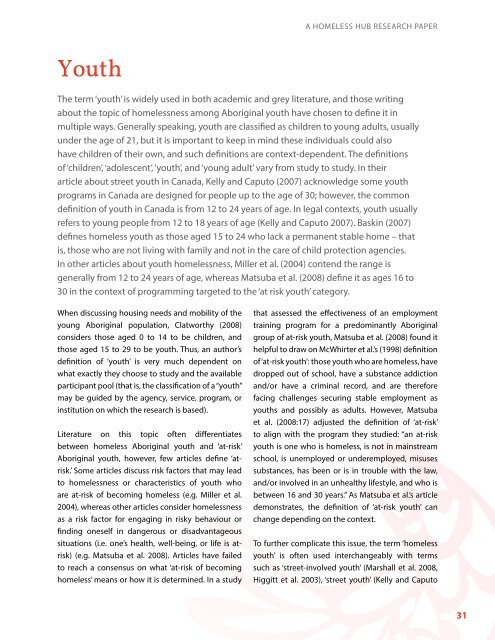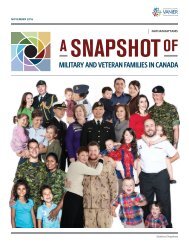1ee0ey1
1ee0ey1
1ee0ey1
You also want an ePaper? Increase the reach of your titles
YUMPU automatically turns print PDFs into web optimized ePapers that Google loves.
A HOMELESS HUB RESEARCH PAPER<br />
Youth<br />
The term ‘youth’ is widely used in both academic and grey literature, and those writing<br />
about the topic of homelessness among Aboriginal youth have chosen to define it in<br />
multiple ways. Generally speaking, youth are classified as children to young adults, usually<br />
under the age of 21, but it is important to keep in mind these individuals could also<br />
have children of their own, and such definitions are context-dependent. The definitions<br />
of ‘children’, ‘adolescent’, ‘youth’, and ‘young adult’ vary from study to study. In their<br />
article about street youth in Canada, Kelly and Caputo (2007) acknowledge some youth<br />
programs in Canada are designed for people up to the age of 30; however, the common<br />
definition of youth in Canada is from 12 to 24 years of age. In legal contexts, youth usually<br />
refers to young people from 12 to 18 years of age (Kelly and Caputo 2007). Baskin (2007)<br />
defines homeless youth as those aged 15 to 24 who lack a permanent stable home – that<br />
is, those who are not living with family and not in the care of child protection agencies.<br />
In other articles about youth homelessness, Miller et al. (2004) contend the range is<br />
generally from 12 to 24 years of age, whereas Matsuba et al. (2008) define it as ages 16 to<br />
30 in the context of programming targeted to the ‘at risk youth’ category.<br />
When discussing housing needs and mobility of the<br />
young Aboriginal population, Clatworthy (2008)<br />
considers those aged 0 to 14 to be children, and<br />
those aged 15 to 29 to be youth. Thus, an author’s<br />
definition of ‘youth’ is very much dependent on<br />
what exactly they choose to study and the available<br />
participant pool (that is, the classification of a “youth”<br />
may be guided by the agency, service, program, or<br />
institution on which the research is based).<br />
Literature on this topic often differentiates<br />
between homeless Aboriginal youth and ‘at-risk’<br />
Aboriginal youth, however, few articles define ‘atrisk.’<br />
Some articles discuss risk factors that may lead<br />
to homelessness or characteristics of youth who<br />
are at-risk of becoming homeless (e.g. Miller et al.<br />
2004), whereas other articles consider homelessness<br />
as a risk factor for engaging in risky behaviour or<br />
finding oneself in dangerous or disadvantageous<br />
situations (i.e. one’s health, well-being, or life is atrisk)<br />
(e.g. Matsuba et al. 2008). Articles have failed<br />
to reach a consensus on what ‘at-risk of becoming<br />
homeless’ means or how it is determined. In a study<br />
that assessed the effectiveness of an employment<br />
training program for a predominantly Aboriginal<br />
group of at-risk youth, Matsuba et al. (2008) found it<br />
helpful to draw on McWhirter et al.’s (1998) definition<br />
of ‘at-risk youth’: those youth who are homeless, have<br />
dropped out of school, have a substance addiction<br />
and/or have a criminal record, and are therefore<br />
facing challenges securing stable employment as<br />
youths and possibly as adults. However, Matsuba<br />
et al. (2008:17) adjusted the definition of ‘at-risk’<br />
to align with the program they studied: “an at-risk<br />
youth is one who is homeless, is not in mainstream<br />
school, is unemployed or underemployed, misuses<br />
substances, has been or is in trouble with the law,<br />
and/or involved in an unhealthy lifestyle, and who is<br />
between 16 and 30 years.” As Matsuba et al.’s article<br />
demonstrates, the definition of ‘at-risk youth’ can<br />
change depending on the context.<br />
To further complicate this issue, the term ‘homeless<br />
youth’ is often used interchangeably with terms<br />
such as ‘street-involved youth’ (Marshall et al. 2008,<br />
Higgitt et al. 2003), ‘street youth’ (Kelly and Caputo<br />
31





